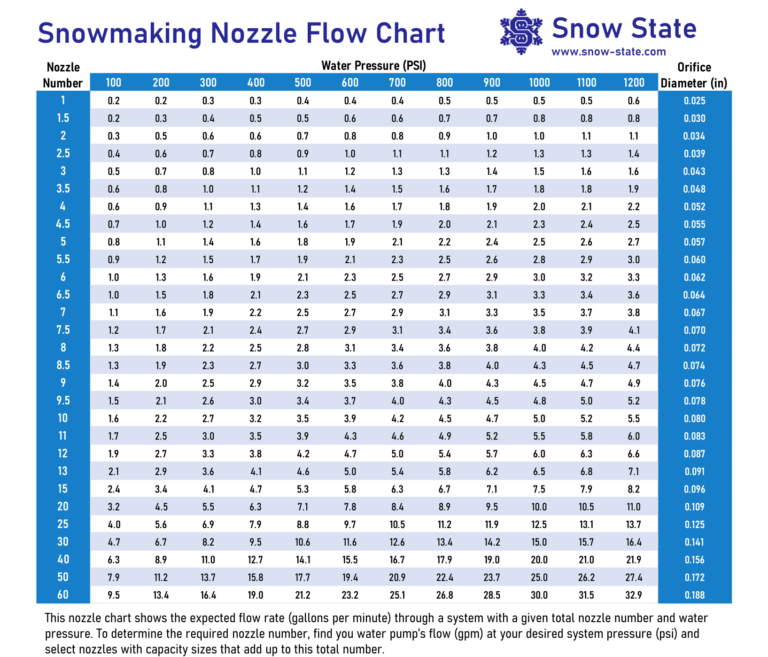Snowmaking Charts
No equations required – simplify the process with these useful charts for home snowmaking applications. Use the wet bulb temperature chart to determine when you can make snow, and the nozzle chart to choose the correct nozzles for your snow gun. Click the images to open the full-resolution version of the chart in a new window!
Wet Bulb Temperature Chart
To make snow, it must be cold enough outdoors to freeze water droplets in the air. We use a quantity called the wet bulb temperature, which takes into account both temperature and relative humidity, to know if it’s cold enough to make snow.
The equation for the wet bulb temperature is actually quite complicated, but this chart makes it simple. Based on the temperature and relative humidity at your location (we recommend using a reliable weather station!), you can see if snowmaking is possible.
Our chart is color-coded based on expected snow quality, which shows how favorable conditions are for snowmaking. Snowmaking becomes possible when the wet bulb temperature is below 28°F, and the process improves in efficiency dramatically as temperatures drop into the mid 20s. Slushy snow quality can be expected even with properly-designed snow guns in “borderline” conditions, but most home snow machines will produce dry and powdery snow with temperatures in the lower 20s and below.
Don’t know the relative humidity? Here’s a simple approximation for the wet bulb temperature from temperature and dew point:
T_w = \frac{2}{3}T + \frac{1}{3}T_d
In the equation above, T is the temperature, T_d is the dew point temperature, and T_w is the wet bulb temperature.
Curious about the importance of wet bulb temperature and how snowmaking works? Learn more in our snowmaking science article!
Snowmaking Nozzle Chart
This nozzle chart is a quick and easy way to select the proper snowmaking nozzles for your system. It lists the flow rate (gallons per minute) through various nozzle orifice sizes (capacity size) at water pressures suitable for snowmaking.
Follow these simple steps to use the nozzle chart:
- Determine the flow rate of your pressure washer or snowmaking water pump, in gpm
- Decide on your desired operating water pressure – we recommend around 700 psi for optimal performance in a wide range of temperatures
- Using the gpm and psi from steps (1) and (2), use the chart to find the total nozzle number required
- Decide how many bulk water nozzles you’ll use in your snow gun design. Choose your water nozzles so that the capacity sizes add up to the total nozzle number calculated in (3)
For example, for a 2.5 gpm pump operating at 700 psi, a total nozzle number of 6 is required. This could be accomplished with one xx06 nozzle, two xx03 nozzles, or even three xx02 nozzles, as the capacity sizes add.
Check out our nozzle calculator, which uses the formula below for more precise numbers:
NN = gpm \times \sqrt{\frac{4000}{psi}}

